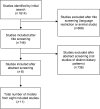Dietary patterns in India: a systematic review
- PMID: 27146890
- PMCID: PMC4890343
- DOI: 10.1017/S0007114516001598
Dietary patterns in India: a systematic review
Abstract
Dietary patterns analysis is an emerging area of research. Identifying distinct patterns within a large dietary survey can give a more accurate representation of what people are eating. Furthermore, it allows researchers to analyse relationships between non-communicable diseases (NCD) and complete diets rather than individual food items or nutrients. However, few such studies have been conducted in developing countries including India, where the population has a high burden of diabetes and CVD. We undertook a systematic review of published and grey literature exploring dietary patterns and relationships with diet-related NCD in India. We identified eight studies, including eleven separate models of dietary patterns. Most dietary patterns were vegetarian with a predominance of fruit, vegetables and pulses, as well as cereals; dietary patterns based on high-fat, high-sugar foods and more meat were also identified. There was large variability between regions in dietary patterns, and there was some evidence of change in diets over time, although no evidence of different diets by sex or age was found. Consumers of high-fat dietary patterns were more likely to have greater BMI, and a dietary pattern high in sweets and snacks was associated with greater risk of diabetes compared with a traditional diet high in rice and pulses, but other relationships with NCD risk factors were less clear. This review shows that dietary pattern analyses can be highly valuable in assessing variability in national diets and diet-disease relationships. However, to date, most studies in India are limited by data and methodological shortcomings.
Keywords: Dietary pattern analyses; Diets; India; PCA principal component analysis; Systematic reviews.
Similar articles
-
Dietary Patterns and All-Cause Mortality: A Systematic Review [Internet].Alexandria (VA): USDA Nutrition Evidence Systematic Review; 2020 Jul. Alexandria (VA): USDA Nutrition Evidence Systematic Review; 2020 Jul. PMID: 35258870 Free Books & Documents. Review.
-
Dietary Patterns and Risk of Cardiovascular Disease: A Systematic Review [Internet].Alexandria (VA): USDA Nutrition Evidence Systematic Review; 2020 Jul 15. Alexandria (VA): USDA Nutrition Evidence Systematic Review; 2020 Jul 15. PMID: 35294140 Free Books & Documents. Review.
-
Dietary patterns in India and their association with obesity and central obesity.Public Health Nutr. 2015 Nov;18(16):3031-41. doi: 10.1017/S1368980015000312. Epub 2015 Feb 20. Public Health Nutr. 2015. PMID: 25697609 Free PMC article.
-
Dietary Patterns and Growth, Size, Body Composition, and/or Risk of Overweight or Obesity: A Systematic Review [Internet].Alexandria (VA): USDA Nutrition Evidence Systematic Review; 2020 Jul. Alexandria (VA): USDA Nutrition Evidence Systematic Review; 2020 Jul. PMID: 35129906 Free Books & Documents. Review.
-
Dietary Patterns and Risk of Type 2 Diabetes: A Systematic Review [Internet].Alexandria (VA): USDA Nutrition Evidence Systematic Review; 2020 Jul. Alexandria (VA): USDA Nutrition Evidence Systematic Review; 2020 Jul. PMID: 35263067 Free Books & Documents. Review.
Cited by
-
Definition of the Traditional Mexican Diet and Its Role in Health: A Systematic Review.Nutrients. 2019 Nov 17;11(11):2803. doi: 10.3390/nu11112803. Nutrients. 2019. PMID: 31744179 Free PMC article.
-
Evolving Food Choices Among the Urban Indian Middle-Class: A Qualitative Study.Front Nutr. 2022 Mar 29;9:844413. doi: 10.3389/fnut.2022.844413. eCollection 2022. Front Nutr. 2022. PMID: 35425799 Free PMC article.
-
Indian food habit & food ingredients may have a role in lowering the severity & high death rate from COVID-19 in Indians: findings from the first nutrigenomic analysis.Indian J Med Res. 2023 Apr;157(4):293-303. doi: 10.4103/ijmr.ijmr_1701_22. Indian J Med Res. 2023. PMID: 37102510 Free PMC article.
-
Assessing Dietary Intake Patterns Through Cluster Analysis Among Adolescents in Selected Districts of Bihar and Assam From India: A Cross-Sectional Survey.Front Nutr. 2021 Nov 25;8:592581. doi: 10.3389/fnut.2021.592581. eCollection 2021. Front Nutr. 2021. PMID: 34901099 Free PMC article.
-
'Old Is Gold': How Traditional Indian Dietary Practices Can Support Pediatric Diabetes Management.Nutrients. 2021 Dec 10;13(12):4427. doi: 10.3390/nu13124427. Nutrients. 2021. PMID: 34959978 Free PMC article. Review.
References
-
- Vecchio MG, Paramesh EC, Paramesh H, et al. (2014) Types of food and nutrient intake in India: a literature review. Indian J Pediatr 81, Suppl. 1, 17–22. - PubMed
-
- Moeller SJ, Reedy J, Millen AE, et al. (2006) Dietary patterns: challenges and opportunities in dietary patterns research. J Am Diet Assoc 107, 1233–1239. - PubMed
-
- Newby PK & Tucker KL (2004) Empirically derived eating patterns using factor or cluster analysis: a review. Nutr Rev 62, 177–203. - PubMed
-
- Popkin BM, Horton S, Kim S, et al. (2001) Trends in diet, nutritional status, and diet-related non-communicable diseases in China and India: the economic cost of the nutrition transition. Nutr Rev 59, 379–390. - PubMed
Publication types
MeSH terms
Grants and funding
LinkOut - more resources
Full Text Sources
Other Literature Sources


